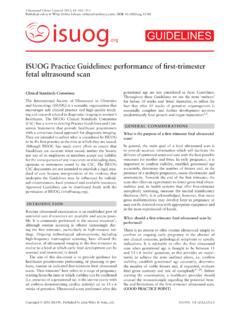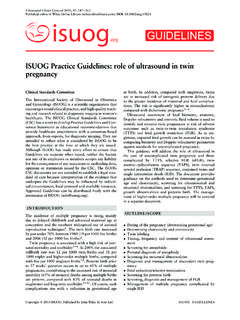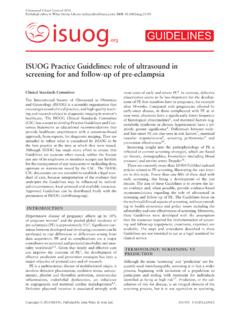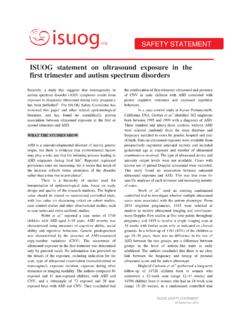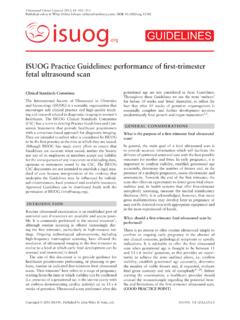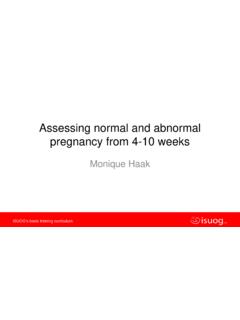Transcription of Ultrasound assessment of fetal biometry and growth
1 Ultrasound Obstet Gynecol2019;53: 715 723 Published online in Wiley Online Library ( ). Practice Guidelines: Ultrasound assessment of fetalbiometry and growthClinical Standards CommitteeThe International Society of Ultrasound in Obstetricsand Gynecology (ISUOG) is a scientific organization thatencourages sound clinical practice and high-quality teach-ing and research related to diagnostic imaging in women shealthcare. The ISUOG Clinical Standards Committee(CSC) has a remit to develop Practice Guidelines and Con-sensus Statements as educational recommendations thatprovide healthcare practitioners with a consensus-basedapproach, from experts, for diagnostic imaging.
2 They areintended to reflect what is considered by ISUOG to bethe best practice at the time at which they were ISUOG has made every effort to ensure thatGuidelines are accurate when issued, neither the Societynor any of its employees or members accepts any liabilityfor the consequences of any inaccurate or misleading data,opinions or statements issued by the CSC. The ISUOGCSC documents are not intended to establish a legal stan-dard of care, because interpretation of the evidence thatunderpins the Guidelines may be influenced by individ-ual circumstances, local protocol and available Guidelines can be distributed freely with thepermission of ISUOG Guidelines aim to describe appropriate assessmentof fetal biometry and diagnosis of fetal growth disorders consist mainly of fetal growth restriction(FGR)
3 , also referred to as intrauterine growth restriction(IUGR) and often associated with small-for-gestationalage (SGA), and large-for-gestational age (LGA), whichmay lead to fetal macrosomia; both have been associatedwith a variety of adverse maternal and perinatal for, and adequate management of, fetal growthabnormalities are essential components of antenatal care,and fetal Ultrasound plays a key role in assessment of fetal biometric parameters measured most com-monly are biparietal diameter (BPD), head circumference(HC), abdominal circumference (AC) and femur diaphy-sis length (FL).
4 These biometric measurements can be usedto estimate fetal weight (EFW) using various differentformulae1. It is important to differentiate between theconcept of fetal size at a given timepoint and fetal growth ,the latter being a dynamic process, the assessment ofwhich requires at least two Ultrasound scans separatedin time. Maternal history and symptoms, amniotic fluidassessment and Doppler velocimetry can provide addi-tional information that may be used to identify fetuses atrisk of adverse pregnancy estimation of gestational age is a prereq-uisite for determining whether fetal size is appro-priate-for-gestational age (AGA).
5 Except for pregnanciesarising from assisted reproductive technology, the dateof conception cannot be determined precisely. Clinically,most pregnancies are dated by the last menstrual period,though this may sometimes be uncertain or , dating pregnancies by early Ultrasound exami-nation at 8 14 weeks, based on measurement of the fetalcrown rump length (CRL), appears to be the most reliablemethod to establish gestational age. Once the CRL exceeds84 mm, HC should be used for pregnancy dating2 ,with or without FL, can be used for estimation of gesta-tional age from the mid-trimester if a first-trimester scanis not available and the menstrual history is the expected delivery date has been establishedby an accurate early scan, subsequent scans should notbe used to recalculate the gestational age1.
6 Serial scanscan be used to determine if interval growth has these Guidelines, we assume that the gestational ageis known and has been determined as described above, thepregnancy is singleton and the fetal anatomy is of the grades of recommendation used in theseGuidelines are given in Appendix 1. Reporting of levelsof evidence is not applicable to these AGA fetus is one whose size is within the normalrange for its gestational age. AGA fetuses typically haveindividual biometric parameters and/or EFW betweenthe 10thand SGA fetus is one whose size is below a predefinedthreshold for its gestational age.
7 SGA fetuses typicallyCopyright 2019 ISUOG. Published by John Wiley & Sons S U O G G U I D E L I N E S716 ISUOG GuidelineshaveEFWorACbelowthe10thpercent ile, although 5thcentile, 3rdcentile, 2SD andZ-score deviation have alsobeen used as cut-offs in the FGR or IUGR fetus is one that has not achieved itsgrowth potential. The difficulty in determining growthpotential means that it is difficult to reach a consensusregarding a clinically useful definition5. This conditioncan be associated with adverse perinatal and neurodevel-opmental outcomes.
8 It has been classified into early-onset(detected before 32 weeks gestation) and late-onset(detected after 32 weeks gestation) types5,6. Fetuses withsuspected FGR will not necessarily be SGA at delivery,and a fetus may fail to achieve its growth potential despitenot being SGA at birth. Similarly, not all SGA fetuses aregrowth-restricted; most are likely to be constitutionally small7. Traditionally, the symmetry of fetal body propor-tions has been seen as indicative of the underlying etiologyfor FGR, with symmetrical FGR thought to correspondto fetal aneuploidy and progressive asymmetrical FGRthought to indicate placental insufficiency.
9 However, fetal aneuploidy can result in asymmetrical FGR8andplacental insufficiency can result in symmetrical FGR9;moreover, the symmetry of body proportions alone is nota consistent prognostic predictor10 LGA fetus is one whose size is above a predefinedthreshold for its gestational age. LGA fetuses typicallyhave EFW or AC above the 90thpercentile, although 95thcentile, 97thcentile,+2SD andZ-score deviation havealso been used as cut-offs in the literature. Macrosomiaat term usually refers to a weight above a fixed cut-off(4000 or 4500 g).
10 Recommendations The following abbreviations should be used to describefetal size and growth : AGA, SGA, LGA and FGR(GOOD PRACTICE POINT). The terms early-onset (detected before 32 weeks gestation) and late-onset (detected after 32 weeks gestation) can be added in case of FGR (GRADE OFRECOMMENDATION: C). The terms symmetrical and asymmetrical FGRshould no longer be used, given that they do notprovide additional information with regard to etiologyor prognosis (GRADE OF RECOMMENDATION: D).
